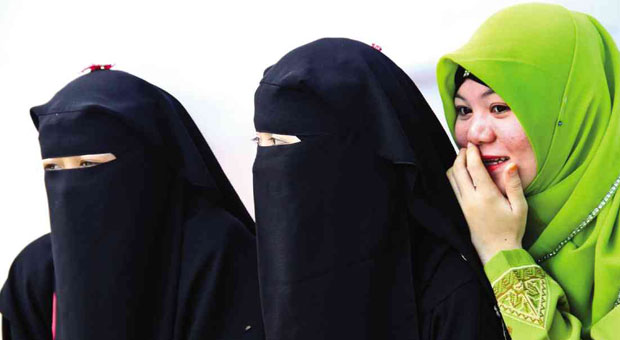Key moments in the history of Moro insurgency

COLOR THEM HAPPY Muslim women are in a festive mood as they gather at the Cotabato City Plaza to show their support for the peace agreement signed Thursday by the Philippine government and the MILF. DENNIS JAY SANTOS/INQUIRER MINDANAO
Following are key moments in the Moro history of the insurgency and the peace talks:
13th century: Arab traders introduce Islam to the Sulu island group near the lower tip of a Southeast Asian archipelago, later to be called the Philippines.
1521: Portuguese explorer Ferdinand Magellan, in a voyage to look for alternate routes for the vital spice trade, lands on Homonhon Island on the Pacific coast, converts natives to Christianity and claims the archipelago for Spain.
1898: The Philippines is ceded to the United States as part of the settlement of the Spanish-American War, with the victors later mounting a bloody pacification campaign against Muslims in the South that lasts several years.
1930s: US authorities encourage Christians to migrate to the southern region of Mindanao, which was mostly populated by Muslims. The policy of Christianizing the region is accelerated in the 1950s and 1960s after the Philippines wins independence. Muslims eventually become a minority in many parts of southern Philippines, fueling resentment directed at rulers in Manila.
Article continues after this advertisement1968: Then President Ferdinand Marcos recruits Filipino Muslims for a covert force to seize Sabah state from Malaysia. But when the recruits complain, at least 23 of them are killed in what becomes known as the “Jabidah Massacre.” The incident helps radicalize Filipino Muslims.
Article continues after this advertisement1969: Muslim scholar Nur Misuari establishes the Moro National Liberation Front (MNLF), which begins an armed campaign to put up a separate Islamic state in the southern third of the country.
1972-1976: Fighting rages between government forces and the MNLF, which is supported by some Muslim countries. Thousands are killed, with whole towns being destroyed in the violence.
1976: Under a deal brokered by the Organization of Islamic Conference, now the Organization of Islamic Cooperation (OIC), the MNLF signs an agreement with the Marcos administration to end hostilities in exchange for the government working to grant greater autonomy in Muslim-populated areas.
1977: Misuari’s deputy, Hashim Salamat, leads a group of key commanders in splitting from the MNLF. They were unhappy with Misuari’s compromise and vowed to continue fighting for independence. Salamat later officially formed the MILF.
1986: Marcos is toppled and replaced by Corazon Aquino, who launches peace talks with the MNLF. The MILF declines to take part.
1996: The MNLF signs a peace settlement with then President Fidel Ramos’ administration and wins limited self-rule over the most impoverished Muslim regions of the South.
1997: The MILF signs a ceasefire agreement and begins peace talks with Ramos’ administration, a process that is disrupted by outbreaks of major fighting.
2008: The Supreme Court blocks a peace deal with then President Gloria Macapagal-Arroyo’s administration that would have given the MILF control over a large area of the South, ruling it was unconstitutional. The decision triggers fighting that leaves more than 400 people dead.
Aug. 4, 2011: President Aquino flies to Japan for a secret meeting with Murad Ebrahim, who had become the new MILF leader after the death of Hashim Salamat in 2003. It is the first direct talks between a Philippine president and an MILF rebel leader since peace talks began. The meeting becomes recognized as a key breakthrough in the peace process.
Oct. 15, 2012: The government and the MILF sign a preliminary agreement in Malacañang outlining a broad road map for peace, with the details on power-sharing, wealth divisions and disarmament later agreed upon during negotiations in Malaysia.
September 2013: Misuari’s armed followers attack the southern port of Zamboanga province in a bid to block the MILF peace deal that they fear would sideline the MNLF leader. The attack sparks three weeks of urban conflict with the military that leaves at least 244 people dead and 116,000 civilians displaced.
Jan. 25, 2014: Government and MILF negotiators conclude talks in Malaysia on the details of the proposed peace agreement.
March 27, 2014: The government and the MILF sign the “Comprehensive Agreement on the Bangsamoro,” which outlines a plan to create a Muslim southern autonomous region with locally elected leaders by mid-2016. In return, the MILF will give up its weapons and form a political party.
RELATED STORIES
Key points on Philippine Muslim peace pact, rebels
After 17 years, Bangsamoro peace pact signed
No more war, poverty, fear, children scampering for safety—Deles